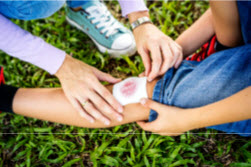How to Treat Severe Bleeding
Bleeding
The blood flows under the pressure in the human body in the blood vessels. If there is no adequate amount of blood flow in the human body, the body collapse. The blood loss usually occurs due to injury, wounds, and major trauma. Bleeding the common cause of death in accident-related deaths. As a first aider, it is your responsibility to control the bleeding in the casualty.
Common sign and symptoms of bleeding emergencies
- Nausea and vomiting
- Pale clammy sweaty, moist skin
- Breathlessness
- Loss of Consciousness
- Weak rapid pulse
- Pallor, Sweating
- Rapid gasping breathing
- Restlessness
- Thirst
- Faintness, dizziness, or confusion
Types of the bleeding
- External bleeding
- Internal bleeding
External bleeding
It is defined as the type of bleeding where the blood loss is associated with wounds. The wounds usually result from cuts, abrasions, lacerations, graze, incisions, and blunt trauma. It shows the direct damage to the blood vessel involved. The damage to artery can be detected if the blood loss is bright red and projectile in nature where’s as venous blood is dark red in colour and slow in the flow. Capillary blood is dark in colour and usually found in the wounds(bruises). Minor bleeding can result from cuts and abrasions.
First aid management of minor bleeding
- Wear the personal protective equipment (gloves)
- Clean the injured area with sterile gauze soaked in normal saline or water.
- Apply the dressing such as a band aid or a non-adhesive dressing held in place with a hypoallergenic tape. This dressing must be changed regularly.
- Do not use cotton wool.
- Consult your local doctor if you cannot remove the dirt yourself. A dirty wound carries a high risk of infection.
- Seek advice from your local doctor If you have not had a booster vaccine against tetanus in the last five years.

Nose bleeding (epistaxis)
It refers to the condition in which the casualty is bleeding from the nose.
First aid management of nose bleeding
- Wear personal protective equipment (gloves).
- Sit the casualty upright and advise them to tilt their head slightly forward.
- Using the thumb and forefinger, squeeze the fleshy part of their nose.
- Apply the pressure for at least 10 minutes.
- Apply the cold compress to the nose and forehead if available.
- Release the pressure on the nostril and check for bleeding
- Advise the casualty to avoid blowing or picking their nose.
- If the bleeding continues more than 20 minutes, seek medical advice.
Severe external bleeding
Small injuries can result in severe external bleeding, depending on where it is on the body, if not treated properly on time. For the first aider it is essential to control the blood loss to prevent it progressing to shock. shock refers to the condition when the casualty no longer has enough blood circulating around their body. Shock is a life-threatening medical emergency.
First aid management for severe external bleeding includes
- Follow DRSABCD (Danger, Response, Send for help, Airway, Breathing, CPR, Defibrillation)
- Wear personal protective equipment (gloves).
- Check for danger before approaching casualty
- Call triple zero (000) for an ambulance. Send someone else to call triple 000.
- Lie the casualty down if they are bleeding severely.
- Raise the injured area above the level of the casualty heart (if possible).
- Remove or cut the clothing to expose the wound
- Advise the casualty to apply direct pressure to the wound with their hand. If the victim cannot apply the pressure, use your hand or pad to apply the pressure.
- Pull the edges of the wound together before applying a dressing or pad.
- If bleeding in not controlled with the initial dressing, do not remove it. Apply fresh padding over the top and secure with a bandage
- Secure it firmly with a bandage.
- Do not remove the object if it is embedded in the wound. Apply pressure around the object.
- Do not apply a tourniquet if the casualty is bleeding severely.
- Keep the casualty NBM (Nil by mouth). Don’t not give anything to eat and drink to the casualty.
- Check the circulation below the wound and condition of the bandage (every 15 mins).
- Do not apply the bandage too tight
- Keep monitoring the casualty until help arrives
Internal Bleeding
Internal bleeding is defined as the type of bleeding in which blood loss occurs internally and cannot been with eyes. There is no obvious evidence of internal bleeding. Internal bleeding can occur in the abdominal cavity, chest cavity, digestive tract, or tissues surrounding large bones, such as the femur and pelvis, if they are fractured. It is essential for the first aider to assess the casualty closely and monitor for the signs of internal bleeding.
Visible internal bleeding
A bruise is the most common type of visible internal bleeding where blood from damaged blood vessels leaks into the surrounding skin. There are several types of internal injury can cause visible bleeding from all body openings.
- Bowel or intestine injury – Bleeding from the anus. Head injury – Bleeding from nose and ears
- Lung injury – coughing up frothy, bloodied sputum (spit)
- Urinary tract injury – blood in the urine(haematuria)
Concealed Internal bleeding (not visible)
Concealed internal bleeding is not visible with naked eyes. The casualty may be bleeding internally even if you cannot see any blood. It is imperative for the first aider to look for the observations that will indicate internal bleeding.
Observations with concealed internal bleeding includes:
- Changes in mental state
- Skin appearance
- Pulse rate
- Respiration
Symptoms of concealed internal bleeding
- Discomfort or pain at the injured site
- Nausea and vomiting
- Loss of consciousness
- Distended and tender abdomen
- Pale, clammy, sweaty skin
- Breathlessness
- Extreme thirst
First aid management for concealed internal bleeding includes
- Follow DRSABCD (Danger, Response, Send for help, Airway, Breathing, CPR, Defibrillation)
- Wear the personal protective equipment (gloves).
- Check for danger before approaching casualty
- Call triple zero (000) for an ambulance. Send someone else to call triple 000.
- Lie the casualty down if they are conscious.
- Cover the casualty with a blanket to keep them warm.
- Raise the casualty’s legs above the level of their heart (if possible).
- Keep the casualty NBM (Nil by mouth). Don’t not give anything to eat and drink to the casualty.
- Reassure and monitor the casualty closely
- If the casualty becomes unconscious, place them in their recovery position. Monitor the breathing. Commence cardiopulmonary resuscitation (CPR) if necessary
 Next |
